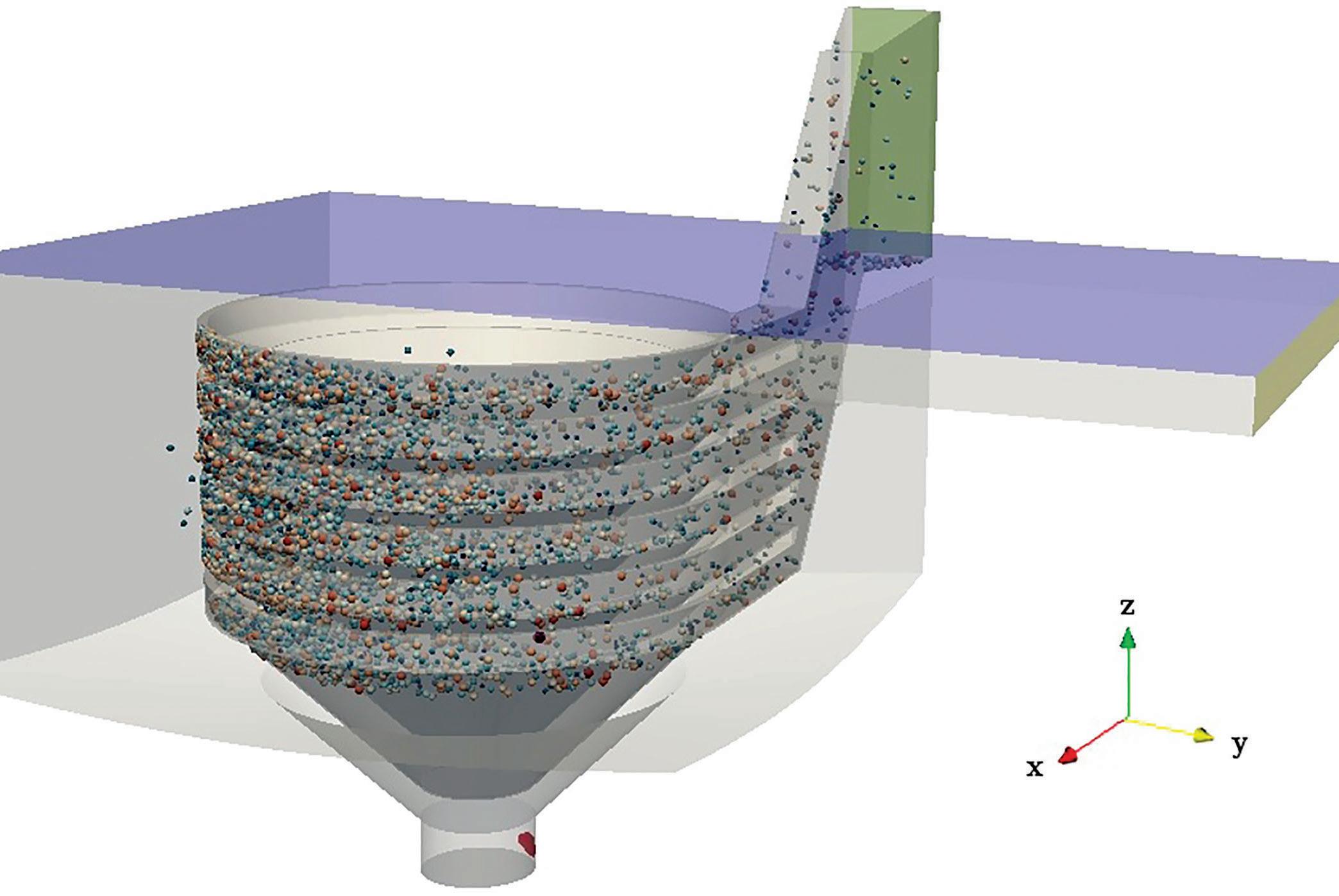
21 minute read
Wastewater Treatment Technology
The outcome of the project was a new stacked tray design that improves grit removal performance
Ground-breaking project leads to advanced wastewater grit removal system
Advertisement
An innovative two-year research project has been completed to optimise an advanced wastewater grit removal technology.
Suspended solids carried in water can cause a range of harmful effects in rivers, lakes and oceans, making the capture and removal of these solids critical for effective environmental protection. To address this problem, the project – between Hydro International and the University of Exeter – focused on optimising the stacked trays that remove high levels of suspended solids from wastewater. By combining optimisation methods and computational fluid dynamics (CFD), the project was able to derive new designs for hydrodynamic solids removal components that would have been difficult or impossible to achieve using traditional engineering methods.
The research was part of a Knowledge Transfer Partnership (KTP), supported by Innovate UK, which ran until September 2021. It builds on years of collaboration between Hydro International and the University of Exeter in the field of CFD. The core of the project involved the optimisation of stacked trays to remove high levels of suspended solids in wastewater, with the primary objectives being improved performance and reduced maintenance requirements. This was a complex, multiobjective, high-dimensional problem, so the team needed to adopt an unconventional approach in order to solve it. The team coupled Bayesian optimisation techniques and CFD modelling, using a
This is the first time that Bayesian optimisation and CFD techniques have been applied in the water sector, which represents a significant step forward in product design excellence. In a sector that has been unfairly criticised for being slow to adopt new technologies and techniques, we’ve shown that there are teams out there willing to push boundaries in order to benefit utilities, consumers and the environment.
Dan Jarman, Hydro International’s Group Technical Manager
Bayesian optimisation toolset originally developed by the world-renowned Machine Learning Group at the University of Exeter. Bayesian optimisation was selected as it can be an order of magnitude more efficient than alternative approaches, such as genetic algorithms, on such complex design problems. The Bayesian optimisation toolset was then connected to CFD simulations, allowing the team to use computing power to automate the design and evaluation process. The team ran the CFD simulations using supercomputers in Exeter and Bristol, with each optimisation run modelling some 300 designs at a time. This would have been impossible to achieve using other optimisation techniques. The team was one of the first in the world to use these techniques on new GW4 Isambard supercomputing architectures, The team subsequently corroborated simulation results through physical testing of prototypes in Hydro International’s hydraulics laboratory in Clevedon. The outcome of the project was a new stacked tray design that improves grit removal performance and enables the production of more compact systems that can handle higher wastewater flows and requires less maintenance—an excellent example of combining academic research with commercial incentives to address real-world challenges. Although the project was focused on improving technologies that will be applied to future iterations of the HeadCell® advanced grit removal system, the findings are fundamental to Hydro International’s core technologies, and will be applicable to other products that rely on the same hydrodynamic principles such as Downstream Defender® and First Defense®. In addition, not only did the project apply methods for complex design optimisation already developed by the University of Exeter, but it also drove new developments in multi-objective optimisation and constraint handling, resulting in new advances in expertise and understanding. Following completion of the project, Innovate UK assessed the KTP and awarded it a Grade A, or “Outstanding”. “We have a long history of investing in new science and new technologies to help our customers, and this project continues that tradition,” said Dan Jarman, Hydro International’s Group Technical Manager. “This is the first time that Bayesian optimisation and CFD techniques have been applied in the water sector, which represents a significant step forward in product design excellence. In a sector that has been unfairly criticised for being slow to adopt new technologies and techniques, we’ve shown that there are teams out there willing to push boundaries in order to benefit utilities, consumers and the environment.”
“This project is an excellent example of what can be achieved when a KTP involves such a wide range of talent and experience,” said Jonathan Fieldsend, Professor in Computational Intelligence at the University of Exeter. “To achieve its outcome, it has needed academics from the Computer Science and Engineering departments, specialists from industry, and support from a highly-skilled impact and business team. It has delivered significant enhancements for an important Hydro International product – in the crucial area of wastewater management – and has also led to advances in applied optimisation techniques and algorithms which have use more broadly in CFD-driven design.” South East Water Operations Director Doug Whitfield celebrates the opening of the Bray Keleher expansion works with the Rt Hon Theresa May, MP for Maidenhead.
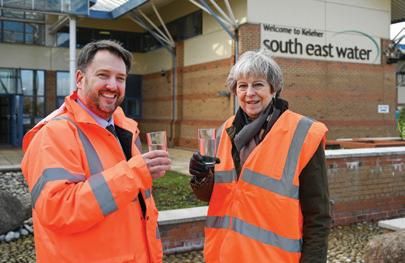
Treatment site doubles pumping capacity
The multi-million-pound expansion to South East Water’s flagship treatment site in Bray is now in service. The site is now capable of pumping up to 68 million litres of water a day - a 50 per cent capacity increase and enough to fill 27 Olympic-sized swimming pools. South East Water pumped more than £25 million into the expansion, which supplies top-quality drinking water to Berkshire, Hampshire and Surrey. Bray Keleher treatment works first opened in 1996 with the vision that the site would need to expand as the community grew. It was initially capable of pumping up to 45 million litres of water a day to customer taps. Construction started in 2018 and involved clearing out thousands of tonnes of earth before installing a series of gigantic tanks. They include a new Rapid Gravity Filter unit, which uses sand to remove pesticides from raw water and a brandnew sludge treatment system. The largest tank, a Granular Activated Carbon tank, can hold up to approximately 500,000 litres of water at a time and uses carbon to remove unwanted odours.
Rt Hon Theresa May MP unveiled a commemorative plaque to mark the completion of the project, in similar fashion to former MP John Gummer when the site was first built in 25 years ago. Desmond Brown, Head of Engineering at South East Water, added: “We have invested a significant amount into expanding our treatment works, highlighting our dedication to ensuring we continue to supply the community with top-quality drinking water as the population grows.”
Intelligent control systems are the future
Stuart Rice of Te-Tech Process Solutions looks at improving the performance of wastewater treatment works.
Like all industries, wastewater treatment can do its part to become “greener” by increasing efficiency and reducing both energy consumption and reliance on chemicals. But the sector is challenged with highly variable influent streams, ever-tightening discharge consents and climate change. Extreme weather events and increasingly drier summers and wetter winters cause huge variations in flow and quality both seasonally and diurnally. Continuous optimisation of wastewater treatment assets can tackle these dramatic fluctuations in influent conditions and ensure that treatment works are operating at peak efficiency all the time. This can be achieved by using an intelligent control system.
Intelligent control systems are able to provide 24/7 management and optimisation of wastewater treatment assets. Learning from historical data and analysing real-time data feeds of process parameters, an intelligent platform can support or directly enact decisions to maximise process performance. Some systems are capable of predictive responses; they can anticipate changes in influent characteristics and prepare a response before they happen. Not only destined for new builds, intelligent control systems are able to improve legacy systems by optimising their performance and extending the life of existing assets.
Dealing with industrial effluents
The Aigües de Manresa municipal wastewater treatment plant at Sant Fruitós De BagesNarvarcles-Santpedor in North East Spain has to deal with consented industrial effluents leading to variable high nitrogen inlet loads. The works consists of two plug flow aeration lanes with variable speed blowers and flow control valves. Historically control was by means of a fixed pressure set point in the main air manifold and a fixed dissolved oxygen set point in the aeration lanes. Under these operating conditions, the plant frequently failed to meet the 15mg/l total nitrogen discharge consent, especially during winter periods. ACA, the Catalan Water Authority finances improvement projects such as this, and Aigües de Manresa decided to install a new control intelligent platform, with modules for aeration optimisation including denitrification cycles, sludge recycling and sludge age. As well as utilising existing instrumentation, they also added new ammonia and nitrate specific ion analysers and optical MLSS probes. The intelligent control system has ensured not only that the treated effluent quality is always met, but has also allowed the works to handle an increase of 30% in total nitrogen load whilst using fewer resources and reducing carbon footprint. Since installing the system, the Sant Fruitós De Bages-Narvarcles-Santpedor works has reduced energy consumption by 15% per m3 of raw sewage treated and 49% per kg ammonia removed.
“The results of implementing the intelligent platform have gone over and beyond our expectations, allowing us to meet nitrogen discharge limits without the need to make any significant investment in the plant”, says Antoni Ventura, Aigües de Manresa’s General Manager. “All in all, this not only resulted in increased treatment capacity and energy efficiency, but also in optimal process stability and sludge quality.” The benefits to the water industry of asset optimisation using intelligent control are clear: ensuring compliance with effluent standards whilst improving sustainability and reducing costs. Not surprising, then, that wastewater treatment facilities around the world are turning to intelligent control systems. The control system installed at Sant Fruitós De Bages-Narvarcles-Santpedor is the CREA® intelligent control platform. It provides real-time control and decision making, and improves plant efficiency and process reliability whilst ensuring compliance with consent limits. With modules to control aerobic and anaerobic biological processes, chemical dosing, sludge age, recycling and sludge thickening, dewatering and digestion, this platform is highly flexible and can be installed on any size of works, process configuration or aeration technology. Te-Tech Process Solutions is offering the CREA® intelligent control platform as part of their end-to-end Asset Optimisation service for wastewater treatment processes, which includes system integration, installation of real-time data monitoring, intelligent control platforms, and in-house panel design and fabrication.
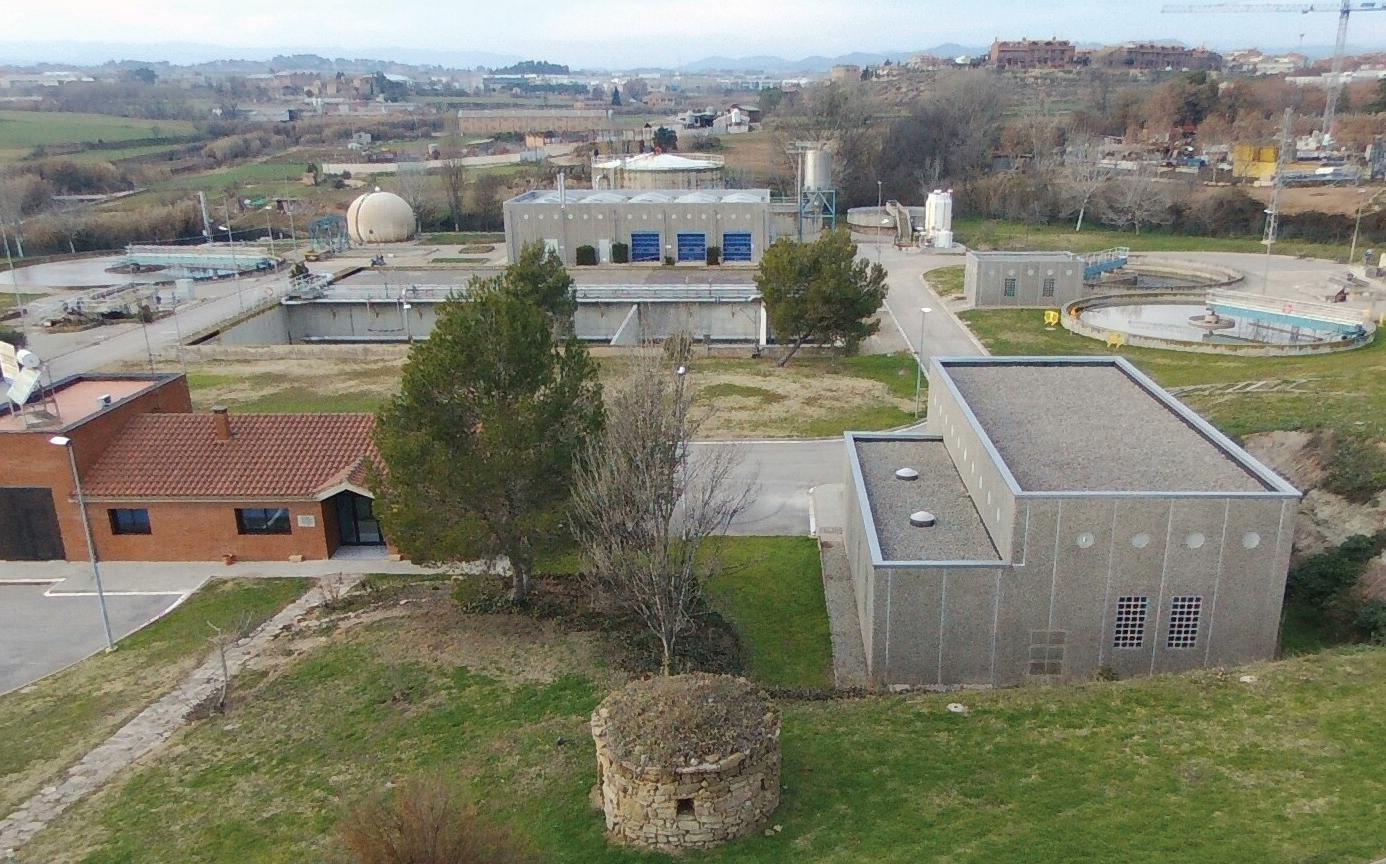
Image © Aigües de Manresa
www.te-tech.co.uk/solutions/waterwastewater-treatment/asset-optimisation Tel: 023 8235 1600 Email: enquiries@te-tech.co.uk
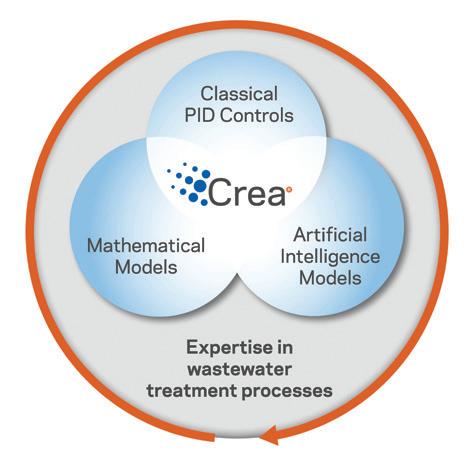

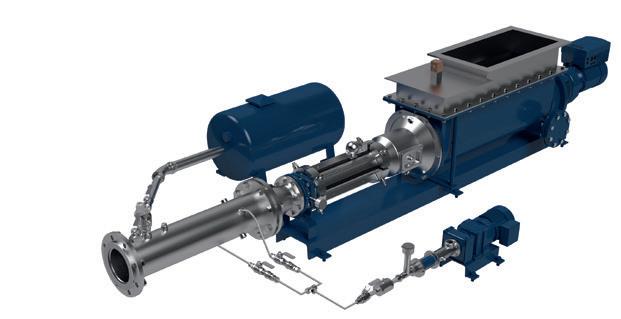


SEEPEX SAI Technology enables Veolia’s sludge cake handling system upgrade at Osberstown STF
The modernisation project for Osberstown STF managed by Veolia involved the upgrade from a very energy intensive thermal drying plant to advanced anaerobic digestion using their Exelys™ thermal hydrolysis process. The scope of supply also included a new dewatering plant with three belt presses and three sludge cake pumps to transfer the dewatered sludge into the THP feed silos.
The modernisation project for Osberstown STF managed by Veolia involved the upgrade from a very energy intensive thermal drying plant to advanced anaerobic digestion using their Exelys™ thermal hydrolysis process. The scope of supply also included a new dewatering plant with three belt presses and three sludge cake pumps to transfer the dewatered sludge into the THP feed silos.
1
Compact, energy-efficient and flexible system for complex process
The upgrade project presented an immediate challenge: how to fit the new THP and dewatering plant into the restricted space of the existing building. The compact design of Veolia’s Exelys™ process significantly reduced the installation space required for the THP. However, due to the space restraints, using a conventional multi-stage pumping system 1 SEEPEX open hopper pumps sit under the belt presses required to transfer 18-27% DS sludge cake through a total of 50m including vertical 2 Discharge pipework from three sludge cake pumps joining a single pipework with long-radius 90° bends would common pipe not be possible. The dewatered sludge handling system 3 SAI technology is an energy efficient solution for long distance needed to have the operational flexibility pumping, proven to significantly to accommodate a fully automated 24/7 reduce operational and total operation with one, two or all three presses in investment costs operation at the same time, discharging into either of the two existing sludge cake silos through common discharge pipework. Low energy and low discharge pressure solution for sludge cake transfer
…I would have to say that the SAI installation has fundamentally changed how I would approach sludge cake transfer design / plant layout in future.
Alan Whitty, Principal Mechanical Engineer at Veolia. Having worked together on many projects over the years, Veolia engaged with SEEPEX to explore how to install a sludge cake handling system within the reduced footprint. Upon consultation, SEEPEX’s Smart Air Injection (SAI) was selected: a highly efficient system involving a progressive cavity pump and pneumatic dense phase conveying technology, able to transport 16-40% DS dewatered sludge with a significantly lower operating pressure requirement. SEEPEX supplied and commissioned three sludge cake pumps with 2.5m custommade hoppers to suit the dimensions of the dewatered belt presses, the associated BLI pumps as well as the SAI controls. The compact SAI system offered considerable savings by allowing the new plant to be installed within the existing sludge dryer building. By using dense phase conveying, Veolia was able to lower the discharge pressure from 16-18 bar to 3-4 bar, enabling smaller cake pumps compared to the 4-stage pumps otherwise required for a conventional system. The robust SAI system requires nearly 50% lower power compared to conventional pumping with subsequent energy cost savings. SAI has proven to have the operational flexibility required by the process and enables the pipework to be emptied when idle, eliminating the risk of cake line blockages; it is easy to operate and extremely reliable. SEEPEX’s engineered solution using SAI technology and their proven cake pumping expertise have enabled Veolia to upgrade their sludge cake handling system which feeds their THP process at Osberstown STF.
2
3
seepex.com
Is grit a bigger problem than we think?
We all know that grit entering water treatment works causes massive issues with process efficiency and that the degree of grit entering the works is vastly underestimated.
The grit removal systems previously offered are seriously lacking in performance and are only removing approximately 30% of the grit entering the works, whilst 70% continually passes through the treatment works damaging mechanical equipment on its way, the rough surface of the grit particles allows other organic matter to bind resulting in clumps causing blockages and accumulation in digestors and primary tanks reducing the output capacity of the works dramatically. The cost associated with grit is in the region of £100,000 per annum. These costs have become accepted and form part of business as usual for most companies and maintenance budgets are burdened with excessive and avoidable costs.
Conventional mechanical rakes are known to be highly inefficient and on average in optimum conditions only remove 20-30%. They are prone to frequent breakdowns and blockages which have to be removed by operator interference which introduces H&S risks. Existing mechanical rakes consume on average 30,000 kW h per annum which generates around 4,000kg of CO2. When we are all looking at carbon reduction this cannot surely be the best option going forwards and a more sustainable solution needs to be found.

EMS The Smart Solution
The HYDRAKE is an innovative hydraulic alternative to the conventional mechanical rake. The intelligent system detects the position of the rake and allows the operator to take full control. In optimum conditions it can remove 95% of all grit particles with a diameter greater than 0.2 mm with a specific gravity of 1.2ms-1 outperforming all mechanical variants. This will lead to improved sludge quality, tank capacity and the reduction of wear to downstream plant.
The design features: 1 Adjustable speed and grit bed depth to suit individual site needs 2 Forward and reverse remote operation to allow removal of blockages without interference
3 Longer rake stroke maximising efficiency 4 Horizontally installed eliminating the need for steel support structures 5 Low-cost servicing 6 Rake angle and length can be adjusted to fit into existing civils works 7 Two-part rake assembly allows for uncomplicated installation 8 Only eight greasing points which can be accessed without major interference The adjustable rake length and angle means the HYDRAKE can be installed in place of mechanical rakes without the need for costly civils works. It is installed horizontally and does not require steel support framework. The installation and commissioning can be completed in 5 days. The variable speed control allows adjustment to match influent flow and a significantly lower operational RPM make the EMS HYDRAKE an energy efficient solution that will improve the grit capture and in turn improve process efficiency, reduce downstream maintenance costs and reduce the carbon footprint of the site.

HYDRAKE comparative performance data:
EMS HYDRAKE Comparison with mechanical rake
Grit removed per annum (tonnes) 264 97% Increase
Energy Consumption (kW h) 7,500 75% Reduction CO2 Emissions (kg) 1780 55% Reduction Annual Maintenance cost (£) 498 90% Reduction
HYDRAKE
EMS HYDRAKE is the best solution for the removal of grit in the waste water treatment industry. It provides a cost effective and sustainable option which is proven to outperforms mechanical rakes. The EMS HYDRAKE is currently operational in several UK treatment works and is demonstrating its benefits.

Customer testimonials
“The system has performed beyond expectation by removing significantly more grit from the system compared to the previous conventional equipment.In the six months running there have been no breakdown, and the greatly increased grit removal has reduced wear on downstream equipment.” “Average emptying requirement frequency of approximately every two weeks.The Site Operative previously reported that when the old rake was in operation the skip was emptied approximately every month” emsindustriesltd.com
Yorkshire Water outlines £13m infrastructure investment for river Wharfe
Yorkshire Water will invest up to £13m in its wastewater network and treatment works, upstream of a stretch of the River Wharfe at Ilkley designated as an inland bathing water, to improve water quality.
The utility company has called on other stakeholders to take steps to tackle additional sources of pollution. The announcement comes as the UK’s first inland bathing water at Ilkley is expected to be rated ‘poor’ by the Environment Agency. In the year since the bathing water designation, Yorkshire Water has been modelling the catchment around Ilkley to understand the factors influencing water quality. The modelling has indicated that, during periods of dry weather, the main contributors to background bacteria were from agricultural operations, local domestic waste patterns, misconnections, and treatment works at Beamsley, Draughton and Grassington. Further modelling will take place in the future to increase available data and improve the understanding of all factors influencing water quality in the river. Enhanced disinfection measures will be applied to the final effluent returned to the environment at Grassington, Draughton and Beamsley treatment works, much like measures taken on the coast, to reduce the impact on water quality. Work will also be carried out to investigate misconnections in the catchment and a scheme to reroute the sewer network in some areas of Ilkley will be carried out to reduce discharges from storm overflows. A project is already underway to upgrade Rivadale CSO as part of this investment. Ben Roche, director of wastewater at Yorkshire Water, said: “We’re keen to play our part in improving water quality in the River Wharfe following the first Environment Agency classification of the inland bathing water at Ilkley. Our modelling indicates acting upstream of the bathing water, at our treatment works at Grassington, Draughton and Beamsley, will deliver the greatest benefit in terms of improving water quality via our assets. We are also assessing the pumping station at Addingham and considering green and sustainable solutions.
“We have outlined up to £13m investment in our network that will help to reduce discharges into the river during prolonged spells of rain and reduce the impact of treated effluent being returned to the environment. This funding is over and above existing investment plans for the current five-year period. “While our investment will help improve water quality, it alone will not guarantee an improvement in the bathing water classification. Our modelling indicates pollution is entering the watercourses from a variety of sources, including misconnections and agricultural land which the river and its tributaries run through. It is important other landowners and stakeholders take action to ensure water quality is improved in the future, with the ultimate aim of improving the bathing water classification.” Work is already ongoing, in collaboration with Bradford Council and the Environment Agency, to reduce infiltration of surface water into the sewer network from Ilkley Tarn. A smart wastewater network pilot for Ilkley will begin this year to trial using smart monitoring, analytics and control solutions to understand the sewer network from homes to treatment works and, once treated, discharges back into the environment.

It is hoped the pilot will offer real-time, end-toend management and control of wastewater assets, reducing intermittent discharges from CSOs and sewer flooding, identifying areas for further investment and improving energy efficiency to reduce carbon emissions.
River Wharfe
We’re keen to play our part in improving water quality in the River Wharfe following the first Environment Agency classification of the inland bathing water at Ilkley. Our modelling indicates acting upstream of the bathing water, at our treatment works at Grassington, Draughton and Beamsley, will deliver the greatest benefit in terms of improving water quality via our assets.
SEEPEX wins order from Thames Water for the most intelligent PC Pump in the world

Through Industry 4.0 technology, SEEPEX has refined its range of progressive cavity pumps to introduce the pump generation of the future, today. The unique patented SCT AutoAdjust technology in combination with SEEPEX digital solutions enables remote adjustment to restore pump performance at the optimal operating point without onsite manual intervention.
SCT AutoAdjust is the next evolutionary step of Smart Conveying Technology (SCT), an ease of maintenance design launched over 10 years ago to simplify and speed up maintenance removing the need for dismantling the suction or discharge pipework. The design of SCT AutoAdjust maintains the same design features of SCT while incorporating hydraulic controls to restore and maintain pump performance.
Remote Adjustment with One Click
The integration of SEEPEX digital solutions with SCT AutoAdjust enables such adjustment to be made remotely from the pump, through the SEEPEX Pump Monitor and SEEPEX Connected Services. This reduces the need for onsite manual intervention and timeconsuming trips to pumps installed in remote, inaccessible locations or large complex sites. All with just one click and without the need for special tools or replacement of components, SCT AutoAdjust enables the pump’s efficiency to be restored remotely and adapt to changes in process conditions. This translates into significantly improved uptime, longer service life of components, reduced need for spare parts and lower life-cycle costs.
The Power of Digital
SEEPEX digital solutions incorporating the SEEPEX Pump Monitor and Connected Services enable predictive and forward planned maintenance to increase resilience, process and asset uptime, and facilitate on time spare parts availability. The Pump Monitor transforms the progressive cavity pump into an intelligent field device that constantly monitors the status and performance, and immediately reports deviations to the user.
Advanced analytics provided by the cloudbased Connected Services, combined with SEEPEX application expertise, deliver process optimisation, improved equipment and plant efficiency, creating previously unimagined potential for increased equipment availability. SCT AutoAdjust offers the ability to maintain both pump performance and efficiency remotely. The predictive and forward planned maintenance afforded by monitoring and advanced analytics increases uptime and spare parts availability. Maintenance becomes easy and simple and unplanned downtime is reduced.
Summary of Benefits
Ability to restore pump performance and efficiency remotely
Predictive maintenance through monitoring and advanced analytics
Forward planned maintenance
Reduced reactive maintenance
Increased uptime
The first order has been received from Thames Water’s Maple Lodge WwTW for SEEPEX’s unique patented SCT AutoAdjust pump technology combined with their Digital Solutions incorporating Pump Technology 4.0. Maple Lodge WwTW will be a showcase, setting new standards for future projects within Thames Water and the water industry. Following the successful delivery by SEEPEX of a project at Thames Water’s Mogden Lane WwTW for a sludge thickening process upgrade, incorporating Digital Solutions and the latest ease of maintenance technology for open hopper pumps, Thames Water approached SEEPEX with a new project with similar synergies at their Maple Lodge WwTW plant. During consultation, the SEEPEX team carried out a full technical review with SEEPEX SCT AutoAdjust, the intelligent pump of the future at Thames Water’s Maple Lodge WwTW SCT AutoAdjust enables remote adjustment to restore pump performance without onsite manual intervention
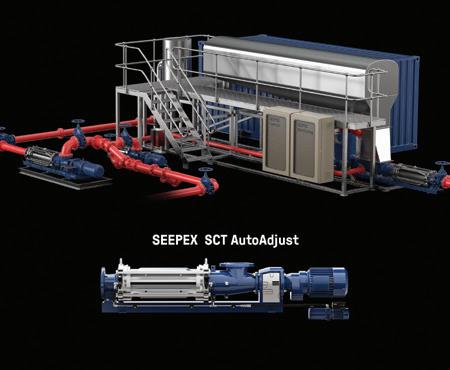
the key stakeholders to understand the challenges and objectives with the operation of the drum thickening process and associated pumps. A comprehensive, commercial and technical proposal was produced which included the most innovative state-of-the-art progressive cavity pumps in combination with Digital Technology. The scope of supply includes the delivery and installation of SCT AutoAdjust drum thickener feed, discharge and back mixing progressive cavity pumps together with SEEPEX Digital Solutions - Pump Monitor, Connected Services and controls.
SCT AutoAdjust technology together with monitoring and cloud services enables remote adjustment to restore pump efficiency and, with advanced analytics, the implementation of predictive and forward planned maintenance as well as process optimisation.






